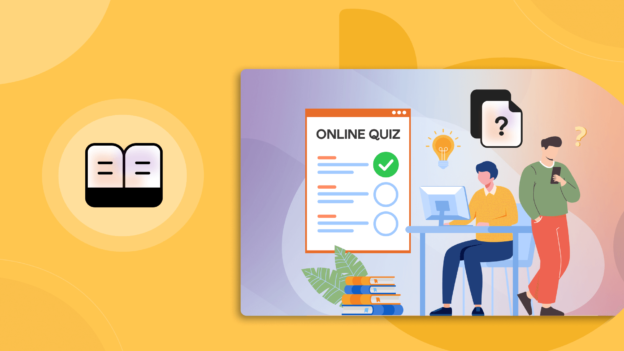In 2017, research stated the Global E-Learning Market would reach $325 billion by 2025. The study said this would be mainly done through online content creation.
Today, mainly due to the pandemic, online teaching is openly done to nurture learners from all walks of life.
Online course creation is so high that many instructors work as full-time course instructors.
Course creation requires a lot of planning and hours of course development.
So to keep it simple, this post will show you how to build an online course for your audience based on their skill levels.
1. Choose your niche
Course research starts with choosing a particular niche. It could be anything depending on your expertise. Such as cooking, tech, business, health, and even makeup.
It is always better to create courses based on the field you are experienced in. Since course development is a time-consuming process, selecting a course based on your experience will only help you to speed up the course development process.
Of course, you can create a course on a completely different niche but this will require you to start from scratch by learning and experiencing the niche as a beginner. This approach is an extremely time-consuming process, but it is certainly possible.
2. Filter your topic
After selecting your niche for your course, you will need to trim your course selection even further.

The second trimming is to select a topic of your favorite niche.
Below are some examples of topics based on some niches.
- Tech: Front-end development, Backend-development, Data Science, Machine learning.
- Cooking: Pastry, Desert, Baking, Grilling, etc.
- Health: Hygiene, Surgery, Nursing.
- Beauty: Makeup, Skincare, Aesthetician activities.
- Video Production: Motion Graphics, Animation, Video Editing.
- Content Creation: Content Marketing, Video Content, Blogging, Email Content.
As you can see, this is how the filters are done.
But this is still not enough!
You will have to filter even further to be more specific.
For example, for the tech niche, the front-end development will include specific topics on web design, HTML and CSS scripts, and programming languages on JavaScript and PHP.
It may seem like a time-consuming task to select a topic. But this only in turn helps you to save time for course development. If the topic research and its content are done right, then you will in turn save hours of course development time.
Another advantage of proper topic research is, it helps to create a gold mine for future course topics. If you are looking to create more courses in the future, you can refer to the topic research you did.
So make sure you do your topic research on an online excel sheet to record your potential course topics.
3. Research your competitors
Yes, there is still more research to be done. But this is the fun part. Competitor research is another gold mine as it makes course development easier.
Researching your competitors means you will need to be in detective mode as it will uncover countless insights which will assist you in your course development.
Below is a list of information you can find out about simply by researching the courses of your competitors.
- The Course modules and submodules will help you plan your own course. You will also be able to see flaws that you can correct in your own course. For example, you may find topics that are too brief-you can add more details to this topic in your own course.
- The instructor’s profile such as the credentials, and personal experience. Knowing this will help you to work on yourself as many learners do take a look at the profile of the instructor.
Yet, you do not have to be perfect to start a course. Simply having confidence or sound experience is enough to take you a long way. For example, working at a well-known company with years of experience is a valid way to prove you are capable of training your audience. - The review section can reveal a course’s strengths and weaknesses.
- Be sure to check other courses your competitor has covered. You may notice topics your competitor has not covered which you can quickly start working on.
- Your competitor’s topic can also reveal which course is most popular. Popular topics reveal courses that are in demand.
- Always have a look at a course’s trailer, it can give you a glimpse of what the course looks like. It reveals which audience the course is meant for. If you notice a course is meant only for advanced users, then you have a gap you can take advantage of by creating a course for beginners only.
3. Find your target audience
Knowing your audience is another research that hardly takes time.
If you have done your competitor’s research by looking at the review section then you will have a clear idea of who your audience will be.
If you would like to know more on this topic you can check out this short post on knowing more about your audience for your online course.
5. Plan the online course content development
Now it’s time to plan the actual content of your course. If the research was done right you should be able to choose a relevant niche and topic for your target audience.

Based on this, start drafting the lessons on your chosen topic. Take good care to build your lessons in a natural sequence. List all of your lessons on a paper or your favorite document editing tool such as Google Docs.
Before you start the videos, plan as much as you need to for the scripts, lessons, and any explanation in your course content.
This is what your content plan will look like.
- Requirements: Under the requirement section, state who the course is meant for. Is this for beginners or advanced users? Is there any skill requirement to gain from this course?
- Description: For this section, describe the niche, followed by the course topic. You can also state the value of your course and why this skill matters in the job sector.
- Introduction: This will be your first video where you introduce yourself to your audience by stating your name, your experience, the course introduction, the benefits of this course, and so on.
- Lesson Title 1: This video is where the actual lessons begin. Always follow a sequence as you add more videos.
- Lesson Title 2: You can add as many separate videos as you want. But each video should not exceed more than 7 minutes.
- Exercises or Tests: Add exercises where needed. Remember to state the exercise in the previous video before the actual exercise. Surprise tests are not pleasant both in college and certainly on an online course!
- Conclusion: The conclusion should thank the audience for using your course. Don’t forget to remind them to check out other courses on your course site. Encourage them to leave a positive review and let them know you are always available to help.
You can find out more about how to create a course outline by following this link.
6. Use any tools to create online training courses
Since courses take time to develop, it is crucial to use any tools that can help save time. Below are some tools you can use to speed up your course development.
- Large monitor: a big part of your course development is video editing. Video editing can be a pain in the neck. Getting a large monitor will ease your task as it helps to edit faster.
- Video editing software: You must invest in video editing software to record and edit your course. We recommend using Camtasia as it is easy to use for any beginners. Camtasia is popular with most instructors. Of course, you can use other video editing tools such as Final Cut Pro, Adobe Premier, and so on. Check out this post on creating videos for your course site.
- Proper laptop or computer: Video editing tends to slow down a computer’s performance. Video editing software and the videos alone quickly take up a lot of space especially if you are a full-time course instructor.
So invest in a strong computer that has good storage, ram, and processor. If you want to keep it simple, just invest in a Macbook Pro with at least 16GB ram and 1TB storage space. If the Macbook holds the recent M1 or M2 chip then that is even better! Macbooks are highly recommended for video editing and content creation. - Canva or Google Slides: You will be presenting most of your content through slides.
We recommend using ready-made slides to save hours of slide preparation. You only want to focus on editing text content on an already-designed slide.
Do not spend time editing designs. Just choose a set of ready-made slides and start working on the text of your topic. Therefore, invest in Canva Pro if you are looking for designed slides. Canva Pro also has images and videos which you can add to your slides to make your course more lively.
You can also use Google slides but it is limited in having a variety of designed slides. Still, there is no harm in using Google Slides. In fact, it is a perfect choice for those on a tight budget. If you are confident in your presentation, explanation, and guidance then there is a chance your audience will overlook your slides lacking some colors. However, it is best not to continue this in the long term. - Document editing tools: This will be needed mainly for your course planning.
You can do this on paper but it will get complicated as you plan your lesson’s scripts, summary, and explanation. So get used to an online document tool as it will help make tracking your lessons far easier than when using paper.
- Project management tools: It is not a necessity to use project management tools. But if you need help remembering, scheduling, and organizing your work you can make use of a project management tool. These tools can also be used to collaborate with other people if your courses are being done as a team.
Examples of project management tools include Asana, Trello, Wrike, Clickup, and Teamwork.
7. Pay special attention to your videos
We have already discussed some points above on video editing. It is easy to overlook mistakes when recording a video.

Remember to review your videos over and over. You can also get someone else to review your videos. You can get valuable feedback and make edits where needed.
If you do get someone to review your course videos, ask them if they are able to understand your lessons and especially your explanation.
If your explanation is not easily understood, you will lose your audience before they reach the end of your course.
8. Choose the best online course platforms
Once you are done creating and testing your course, it is now time to publish your course.
The best way to publish your course is by having your own course site. This can be done by using the BuddyBoss platform which will instantly let you start your own course site.
This strategy will protect your audience from getting distracted by viewing the courses of your competitors.
You do not have to set up a separate site, using the BuddyBoss platform is enough to build, publish and market your coaching business.
9. Don’t forget to market and build your audience
Once your course is published, your final task is to market your course.
Post updates on your social media profile about your course publication. Tell your friends, neighbors, or colleagues. Open a separate social media profile for your course site and start ringing the bells from there to bring traffic to your site.
10. Analyze and repeat the cycle
If you use the BuddyBoss platform to host your courses online, you will be able to analyze how well your courses are doing. You will start to receive reviews and comments.

Your sales and traffic will tell you a lot about how well your courses are doing.
For example, BuddyBoss integrates Google Analytics 4 (the latest version of Google Analytics) so you can judge how well your course content is doing with your audience.
As you analyze your course’s performance, you will soon find the need to create more courses. Because courses need to be updated, upgraded, and sometimes created from scratch.
Once your coaching business starts to grow, you will need to create more course topics to keep your users interested.
Of course, this will happen if you create the courses as described in this post.
Conclusion
If this is your first time creating a course topic, then create a course on a topic you are most experienced on. You can also pick a topic that is easy to work with. Starting off this way will quickly help you to get started.
The goal is to start and then build your way up with more courses. You can also create a variety of course topics using the same topic.
To elaborate, it is possible for setting up an online course for different skill levels using the same topic.
For example, you can teach writing for beginners and then create a more advanced course for writing using the same course structure used for beginners.
The advanced course will have to be updated with tougher exercises, deeper concepts, and perhaps more lessons.
You can check out our website if you want to find out more about how to create courses for your coaching business. We have a whole team guiding and helping instructors start their own coaching businesses.












